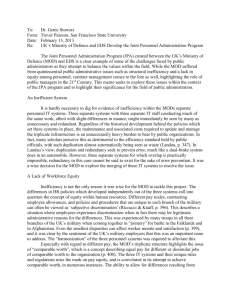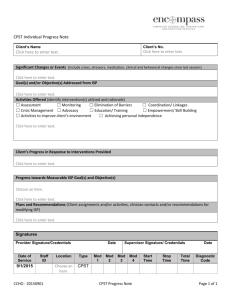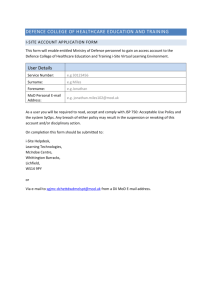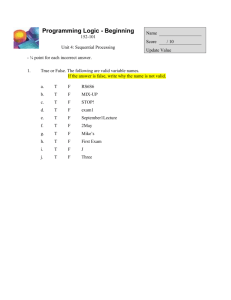A Different Kind of Partnership
advertisement
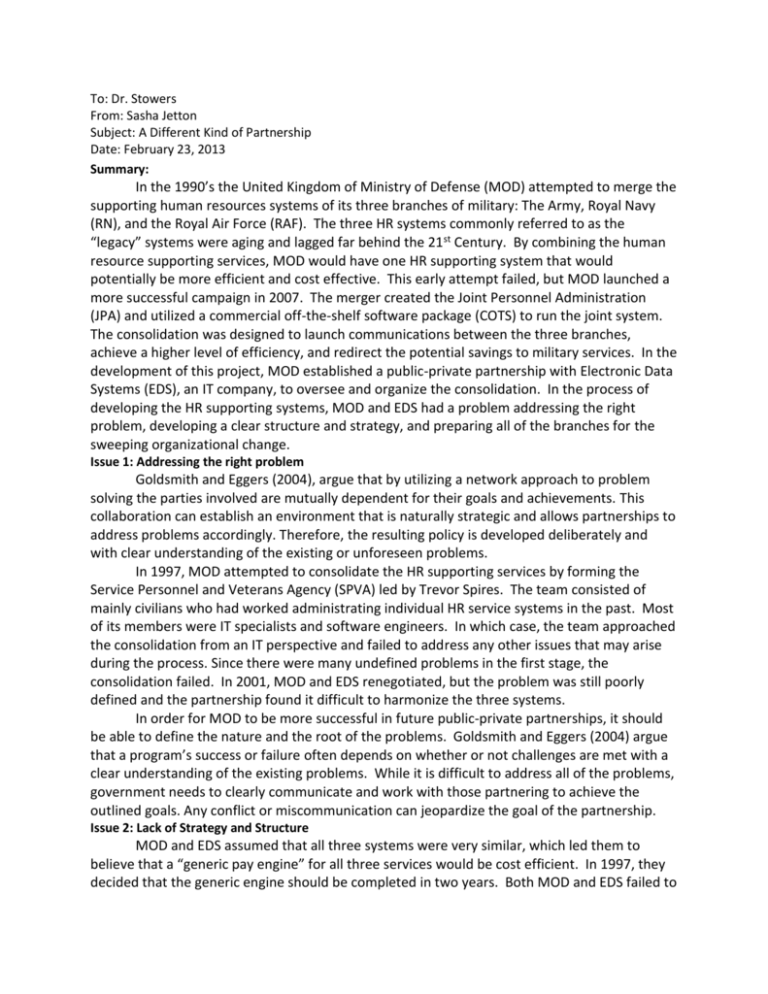
To: Dr. Stowers From: Sasha Jetton Subject: A Different Kind of Partnership Date: February 23, 2013 Summary: In the 1990’s the United Kingdom of Ministry of Defense (MOD) attempted to merge the supporting human resources systems of its three branches of military: The Army, Royal Navy (RN), and the Royal Air Force (RAF). The three HR systems commonly referred to as the “legacy” systems were aging and lagged far behind the 21st Century. By combining the human resource supporting services, MOD would have one HR supporting system that would potentially be more efficient and cost effective. This early attempt failed, but MOD launched a more successful campaign in 2007. The merger created the Joint Personnel Administration (JPA) and utilized a commercial off-the-shelf software package (COTS) to run the joint system. The consolidation was designed to launch communications between the three branches, achieve a higher level of efficiency, and redirect the potential savings to military services. In the development of this project, MOD established a public-private partnership with Electronic Data Systems (EDS), an IT company, to oversee and organize the consolidation. In the process of developing the HR supporting systems, MOD and EDS had a problem addressing the right problem, developing a clear structure and strategy, and preparing all of the branches for the sweeping organizational change. Issue 1: Addressing the right problem Goldsmith and Eggers (2004), argue that by utilizing a network approach to problem solving the parties involved are mutually dependent for their goals and achievements. This collaboration can establish an environment that is naturally strategic and allows partnerships to address problems accordingly. Therefore, the resulting policy is developed deliberately and with clear understanding of the existing or unforeseen problems. In 1997, MOD attempted to consolidate the HR supporting services by forming the Service Personnel and Veterans Agency (SPVA) led by Trevor Spires. The team consisted of mainly civilians who had worked administrating individual HR service systems in the past. Most of its members were IT specialists and software engineers. In which case, the team approached the consolidation from an IT perspective and failed to address any other issues that may arise during the process. Since there were many undefined problems in the first stage, the consolidation failed. In 2001, MOD and EDS renegotiated, but the problem was still poorly defined and the partnership found it difficult to harmonize the three systems. In order for MOD to be more successful in future public-private partnerships, it should be able to define the nature and the root of the problems. Goldsmith and Eggers (2004) argue that a program’s success or failure often depends on whether or not challenges are met with a clear understanding of the existing problems. While it is difficult to address all of the problems, government needs to clearly communicate and work with those partnering to achieve the outlined goals. Any conflict or miscommunication can jeopardize the goal of the partnership. Issue 2: Lack of Strategy and Structure MOD and EDS assumed that all three systems were very similar, which led them to believe that a “generic pay engine” for all three services would be cost efficient. In 1997, they decided that the generic engine should be completed in two years. Both MOD and EDS failed to realize that each system varied significantly. There was not much knowledge about the differences in the HR practices, but it became clear that a single generic system would not work for the three branches. Therefore, EDS informed MOD that they could not fulfill their contract. Structure provides the outline for the work of organizations (Hill & Lynn, 2009). By not completely defining the problem, the public managers in this case did not adhere to the structural dimensions of their environment. In the first attempt, MOD failed to set forth the criteria by which the partnership would be deemed a success or failure. As a result, the contract was mismanaged and the collaboration failed. Hill & Lynn (2009) argue that the public manager should understand how much of the project will be handled by the contracted partner. MOD leadership failed to communicate their needs appropriately and this led to slowing of the process. In 2001, MOD and EDS put together several work groups to work on harmonization across a number of areas and they agreed to renegotiate their contract. In the second attempt, the plan was much more strategic and forthcoming. It is important for public managers to think strategically and consistently (Hill & Lynn, 2009). MOD and EDS began to be more concerned with the long-term goals of the project. Both EDS and MOD began to feel committed to the project and trusted one another to move forward with collaboration. While the project was not perfect, the relationship between MOD and EDS formulated around a common theme –partnership. Issue 3: Sweeping Organizational Change Hill & Lynn (2009) argue that sweeping changes may affect culture, as the organization adjusts to incorporate new ways of organizing work. MOD is introducing a major organizational and cultural change that potentially could have created resistance. The employees were not informed and given the opportunity to be active participants in the process. Organizational theory places an emphasis on how the individuals within an organization interact, and defines the division of labor based on capacities, skills, and expertise. Other than upper management, MOD leadership did not attempt to utilize the expertise of its staff members. RAF received the first rollout and the organization was not prepared for the sweeping change. The RAF problems created hesitance within the RN and the Army, but MOD moved forward with JPA. It is important to understand employees’ reactions to sweeping change. Ott, Parkes, & Simpson (2008) argue that changing the organizational structure alters the norms, realities, beliefs, and values of an organization. The transition to RN and the Army went smoothly, but there were winners and losers. Prior to the consolidation, each branch had separate systems for pay allowances. Once consolidated, one system was used to identify and distribute the allowances to its staff. This led to some reduction in pay for a number of military personnel and created resentment towards JPA. Employees were relatively comfortable with the old system and the new system forced them to handle their personnel issues through an online self-service application. This sweeping organizational change created challenges within the ranks, but did lead to some cost saving outcomes. JPA was able to reduce the number of unit-based HR specialists, which led to a reduction in duplicate costs. Overall, the new system was successful, but not without sweeping organizational change and some resistance from staff. References Goldsmith, S., & Eggers, W.D. (2004). Governing by network: The new shape of the public sector. Washington, DC: The Brookings Institute. Hill, C.J., & Lynn Jr, L.E. (2009). Public management: A three-dimensional approach. Washington, DC: CQ Press. Ott, S.J., Parkes, S.J., & Simpson, R.B. (2008). Classic readings in organizational behavior. (Fourth ed.). Belmont, California: Thomson Higher Education.



